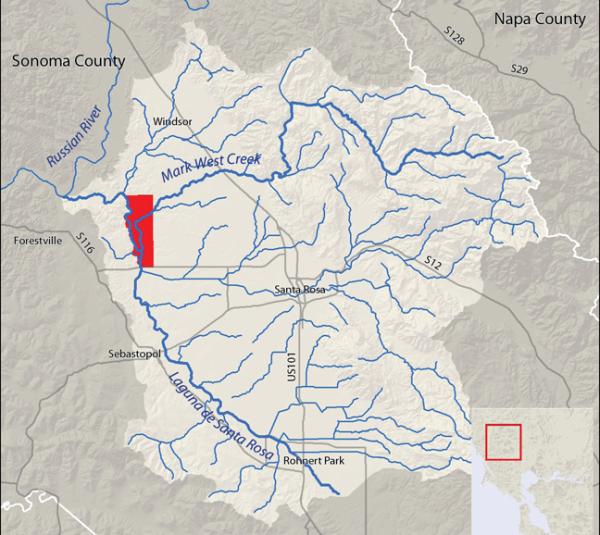Lower Laguna de Santa Rosa and Mark West Creek: Changes in Historical Channel Alignment
Over the past century and a half, the hydrology of the Laguna de Santa Rosa watershed has been altered by a variety land use changes, including urbanization, agricultural development, draining and filling of wetlands, and channelization of streams. These changes have impacted the function of the Laguna and Mark West Creek and contributed to a range of contemporary management problems, including habitat degradation, impaired water quality, altered sediment dynamics, salmonid stranding, flooding, and trash accumulation. In the downstream portion of the watershed, major changes in the historical channel alignment of lower Mark West Creek have altered flow and sediment dynamics in both Mark West Creek and the Laguna.
This study reconstructed the historical channel alignment of lower Mark West Creek, lower Laguna de Santa Rosa, and surrounding tributaries during the mid-19th century, and documented major changes in channel alignment over the past 150 years. In the mid-19th century, lower Mark West Creek flowed
northwest across the Santa Rosa Plain to its confluence with the Laguna de Santa Rosa. Between the late-19th century and the mid-20th century, a series of diversions (possibly combined with natural course shifts) caused the channel to move progressively further to the south. Today, the Laguna-Mark West Creek confluence is located approximately two miles south of the historical confluence. Over this same period, portions of lower Laguna de Santa Rosa and many smaller tributaries were channelized.
Partners:
Funders:
Associated Staff:
Associated Data:
Programs and Focus Areas:
Resilient Landscapes Program
Historical Ecology
Watershed Science & Management
Primary Project
 Laguna de Santa Rosa Historical Ecology Initiative
Laguna de Santa Rosa Historical Ecology Initiative
The Laguna de Santa Rosa (Laguna) watershed spans 256 square miles and supports a unique complex of biologically diverse ecosystems. Containing the urban centers of Santa Rosa, Sebastopol, Cotati, Rohnert Park, and Windsor, the Laguna watershed encompasses one of the largest floodplains in California. Historically the Laguna watershed supported a diverse ecosystem consisting of oak savanna/vernal pool complexes, riparian forest, emergent and off channel wetlands, and open water.






